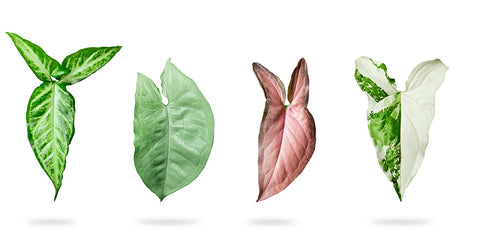SYNGONIUM PLANT CARE GUIDE
HOW TO GROW AND CARE FOR
SYNGONIUMS
| Botanical Name | Syngonium spp. |
| Family | Araceae |
| Plant Type | Tropical flowering plant |
| Mature Size | Varies by species, typically compact |
| Light | Thrives in bright, indirect light |
| Medium | Well-draining, aerated aroid mix |
| Native Areas | Tropical regions of Central and South America |
| Toxicity | Syngonium plants may be toxic if ingested, and the sap can be a skin and eye irritant. |
| Common Species | Syngonium podophyllum, Syngonium erythrophyllum, Syngonium macrophyllum, Syngonium wendlandii, Syngonium angustatum, Syngonium chiapense, Syngonium rayii, Syngonium peliocladum, Syngonium neglectum, Syngonium angustatum, Syngonium hoffmannii |
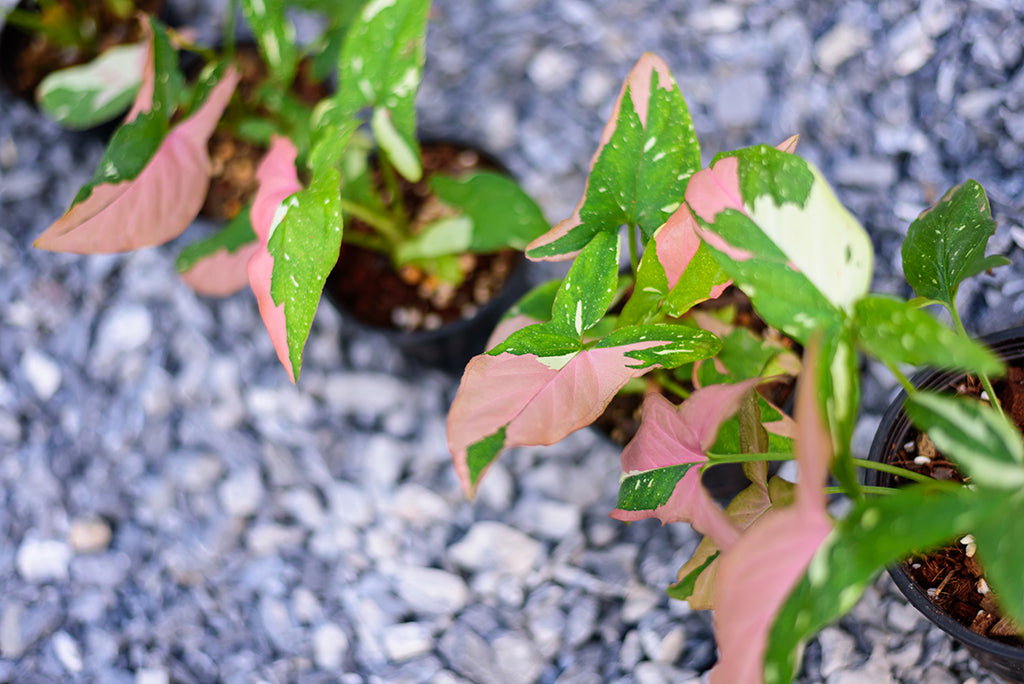
📷 Syngonium Red Spot Tricolour
WELCOME TO YOUR COMPLETE GUIDE TO CARING FOR A SYNGONIUM
HOW MUCH LIGHT DOES A SYNGONIUM NEED?
Syngonium are generally adaptable houseplants that thrive in moderate to bright indirect light. They can tolerate lower light conditions, but their growth may slow down and produce fewer leaves with less vibrant colours. On the other hand, exposing them to too much direct sunlight can lead to leaf burn. A good rule of thumb is to provide them with bright, filtered light or partial shade. Placing them near a window with sheer curtains or at a distance from sources of intense sunlight is often ideal for their growth and well-being.
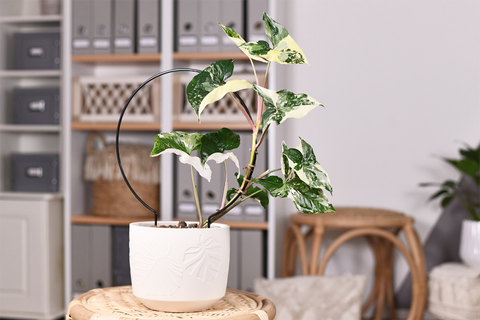
HOW OFTEN SHOULD I WATER A SYNGONIUM?
Before reaching for your watering can, ensure that your Syngonium needs a drink. The key indicator is the top of the soil (3-5cm) is dry, then it's watering time. Watering frequency hinges on your home's temperature and humidity levels, generally ranging from every 7-10 days.
In the warmer embrace of summer, your Syngonium may appreciate a bit more hydration compared to the cooler winter months. Always perform the dryness test by checking the medium; this helps you avoid overwatering, which can lead to waterlogged soil and root rot. Strike the right balance to keep your Syngonium thriving and happy.

WHAT IS THE BEST POTTING MEDIUM FOR SYNGONIUM?
A well-draining potting mix is crucial for Syngonium to thrive as houseplants. You can create a suitable potting medium by following our Simple Three Ingredient Aroid Mix or our Ultimate Premium Aroid Mix recipes. These mixes provide good aeration and drainage, preventing the soil from waterlogging.
WHAT IS THE BEST TEMPERATURE FOR SYNGONIUM?
Syngonium generally thrive in a temperature range of 15-29°C. They can tolerate slightly lower temperatures but are sensitive to cold drafts and temperatures below 10°C, damage their foliage. Additionally, high temperatures above 29°C can cause stress to the plant and result in leaf discolouration or leaf drop. Therefore, it is best to maintain a consistent temperature within the recommended range to ensure the healthy growth of your Syngonium.
WHAT IS THE BEST HUMIDITY FOR SYNGONIUM?
Synginium love moderate to higher humidity levels, so ensuring a humidifier is nearby can be helpful, especially in indoor environments with drier air. You can increase humidity around your plants by grouping them together using pebble trays or a cloche.
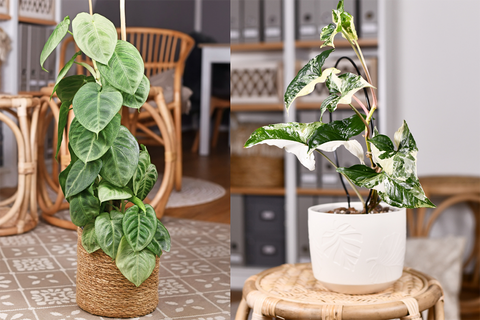
Right: Syngonium podophyllum 'Fantasy'
TRAINING SYNGONIUM ONTO A TRELLIS OR POLE
Syngonium can be encouraged to climb with the help of stakes, moss poles, or other supports. Regular pruning can also promote bushier growth and control the length of the vines. The climbing nature of Syngonium adds to their versatility as indoor plants, allowing them to be grown as hanging plants or climbers, depending on your preference and the available space.
- Choose a sturdy trellis or moss pole tall enough to support the growing plant. The trellis should be made of a material the plant can easily attach itself to, such as bamboo or plastic.
- Position the trellis inside the pot, so it is directly in contact with the soil, ensuring it is stable and secure.
- Guide the plant's stems towards the trellis or pole, not damaging the leaves or roots.
- Use plant ties to attach the stems to the trellis or pole. Ensure the ties are not too tight and do not damage the stems.
- As the plant grows, guide its stems towards the trellis or pole and secure them with ties.
- Prune any stems not growing towards the trellis or pole, as this will encourage the plant to focus its energy on the trained stems.
- Water the plant regularly and fertilise it monthly to encourage healthy growth.
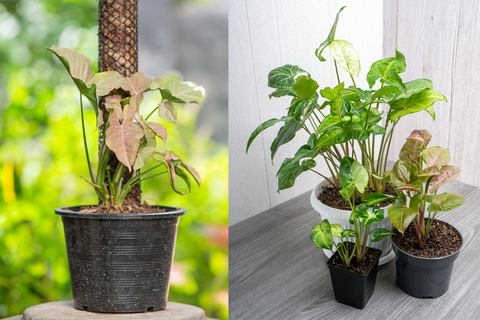

WHAT'S THE BEST FERTILISER FOR SYNGONIUM?
Growth Technology Foliage Focus is an excellent choice for fertilising Syngonium plants. This balanced, liquid fertiliser is specially formulated for foliage plants, providing all the necessary nutrients for healthy growth and vibrant foliage. Foliage Focus contains a blend of macro and micronutrients and organic compounds readily absorbed by the plant's roots and foliage. The fertiliser is easy to use and can be added directly to the soil when watering. Regularly applying Foliage Focus can help promote healthy growth, prevent nutrient deficiencies, and enhance the plant's resistance to pests and diseases. Overall, Foliage Focus is a reliable and practical choice for keeping your Syngonium thriving and looking its best.
WHAT ARE COMMON SYNGONIUM PESTS, AND HOW DO YOU TREAT THEM?
Syngonium, like most plants, is susceptible to certain pests. Common pests include mealybugs, scale insects, thrips, and aphids.
Aphids are small, soft-bodied insects that feed on plant juices. They can be identified by their pear-shaped bodies, usually black, green, yellow, or brown. Aphids can weaken the plant by sucking out its sap, leading to yellowing and/or wilting leaves. Treatment for aphids includes spraying the plant with a strong water stream or using an insecticidal soap or neem oil solution.
Mealybugs are small, white, fuzzy insects that feed on plant sap. They are usually found in clusters on the underside of the leaves. Mealybugs can be treated with insecticidal soap, neem oil, or a cotton swab dipped in rubbing alcohol to wipe them off.
Scale insects are tiny, flat, oval-shaped pests that feed on plant sap. They can also be identified by the white, waxy coating they produce. Treatment for scale insects includes wiping them off with a cotton swab dipped in rubbing alcohol or spraying the plant with neem oil.
Spider mites are tiny, eight-legged arachnids that feed on plant sap. They cause yellowing and stippling of the leaves and webbing on the foliage. Treatment for spider mites includes spraying the plant with Kill-a-mite or Stealth. By monitoring these common pests and treating them promptly, you can ensure your plant stays healthy and thrives.
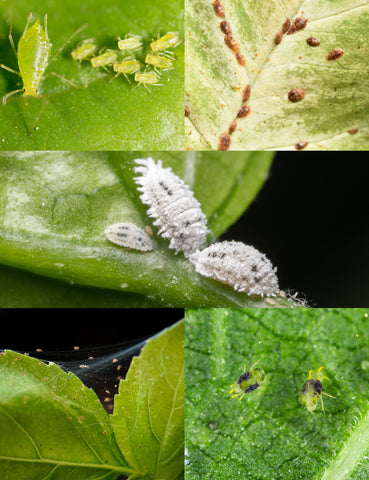
HOW TO PRUNE A SYNGONIUM
Identify dead, damaged, or diseased leaves, stems, or roots to prune your Syngonium. Use sharp, clean pruning shears to make clean cuts, taking care not to damage the healthy parts of the plant. You can also prune to control the plant's size and shape, cutting back any stems growing too long or in unwanted directions. Make sure to prune in spring or summer when the plant is actively growing and can recover from the cuts quickly. Regular pruning can help to keep your Syngonium healthy and looking its best.
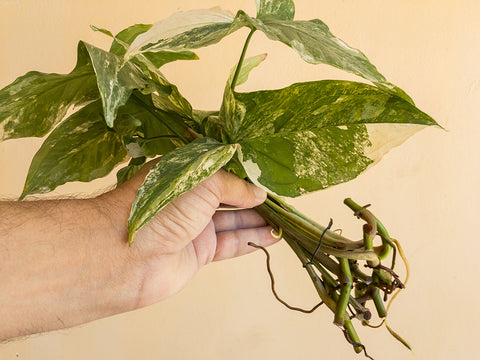
📷 Syngonium cuttings
HOW TO PROPAGATE A SYNGONIUM
There are many ways to propagate Syngonium including water propagation, sphagnum moss, perlite, vermiculite and soil propagation. For water propagation, take a stem cutting with several leaves and place it in a jar of water, ensuring the bottom of the stem is submerged. Change the water every few days and wait for roots to develop. For sphagnum moss propagation, wrap a stem cutting in damp sphagnum moss and cover it with plastic wrap to create a humid environment. For perlite or vermiculite propagation, mix with a bit of water to make a damp but not too wet mixture, and plant the stem cutting in the mix. Water and wait for roots to develop. Once roots have formed, plant the cutting in a pot with well-draining soil and care for it like a mature Syngonium plant.
WHEN DO YOU NEED TO RE-POT A SYNGONIUM?
Repotting a Syngonium is necessary when the plant has outgrown its pot or when the soil has depleted its nutrients. It is best to repot when the plant is actively growing, so Spring is the best time to repot. If your plant has become too root-bound, it should be re-potted immediately. When repotting, choose a pot slightly larger than the current pot, not too large or it will cause the soil to become waterlogged, and the roots may rot. Using fresh potting medium will help to prevent disease and ensure the plant has all the nutrients it needs. When repotting, make sure to keep the root ball intact and to water thoroughly.

WHAT SORT OF POTS DO SYNGONIUM LIKE?
Syngonium plants prefer a pot with drainage holes in the bottom to ensure that the soil does not become waterlogged. It is also essential to choose a pot slightly larger than the current root system of the plant, as Syngonium will quickly outgrow a pot that is too small.

ARE SYNGONIUM TOXIC TO PETS AND CHILDREN?
Yes, Syngonium plants contain calcium oxalate crystals, which can be toxic to pets if ingested. Ingesting parts of the Syngonium plant, such as leaves or stems, may cause irritation and discomfort in pets' mouths, tongues, and throats. Symptoms of ingestion can include drooling, difficulty swallowing, and nausea.
It's essential to keep Syngonium out of reach of pets or place them in areas where pets cannot access them. If you suspect that your pet has ingested any part of a Syngonium plant and is exhibiting symptoms of toxicity, it's advisable to contact your veterinarian promptly for guidance and assistance. Read more on the Common Indoor Plant That Are Toxic To Pets.
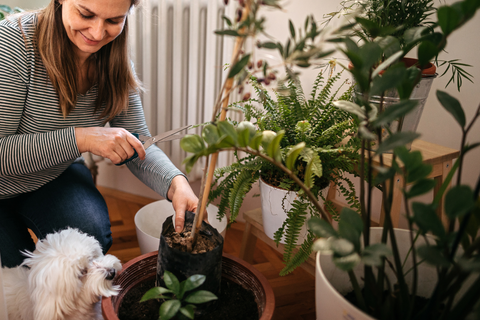
A List Of Well-Known Syngonium:
- Syngonium podophyllum '’Starlight’
- Syngonium podophyllum ‘Scrambled Eggs’
- Syngonium podophyllum ‘Red Spot Tricolour’
- Syngonium podophyllum 'Pink Splash’
- Syngonium podophyllum ‘Panda’
- Syngonium podophyllum 'Dwarf Princess’
- Syngonium podophyllum 'Pixie’
- Syngonium podophyllum ‘Strawberry Milk -Arrowhead’
- Syngonium podophyllum 'Silver Pearl’
- Syngonium podophyllum ‘Mojito”
- Syngonium podophyllum 'Confetti'
- Syngonium podophyllum 'Mosaic’
- Syngonium podophyllum ‘Goldie”
- Syngonium podophyllum ‘Fantasy’
- Syngonium podophyllum 'Aurea’

